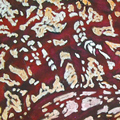‹ paintings
The Art of Eddie Burrup
1940s — 2000, a continuum
 |
 |
 |
 |
 |
 |
 |
 |
 |
| < back | next > | |
10 to 18 of 50 artworks |
||
The extensive body of work, visual and written, created between the years 1994 and 2000 that comprises The Art of Eddie Burrup is the final phase in the evolution of Elizabeth Durack’s oeuvre. In spirit and purpose it aligns with all that came before; it can be traced back some 60 years. It was nascent in the 1930s and probably first emerged in recorded visual form via The Whirlwind drawings and paintings of 1940–41. Towards the end of her life — through her daemon, Eddie Burrup — Elizabeth Durack distilled a lifetime of living and learning, of giving and taking, of exploring, reflecting upon and of recreating lost worlds of an ancient culture. Her art is homage to this culture. It also honours and fulfills an exceptional talent. |
||

- Djanba!
- 1996
- resiste, acrylic and ochre on canvas
- 200 x 100 cm
- exhibited: Rebecca Hossack Gallery, London, July 2000
- collection: estate of Elizabeth Durack
- Artist's note
Considerable mystery surrounds the identity and origin of Djanba. While he may be a place-being of post–colonial emergence, he could equally be the re–emergence of a Being of great antiquity. He is not tied to one place and can appear anywhere at any time. It is sometimes said that he originated in Queensland and that he circulated south, west and north by following stock routes ... The anthropologist/priest EA Worms attempted to align Djanba and his career with a Christ–like manifestation.
Some say he is the personification and the reincarnation of Argyle Boxer, a Queensland Aboriginal who came to Kimberley in the 1880s with the cattle men.
Boxer was noted for sudden and unexpected appearances ... he did not die in Darwin, as reported, but simply goes on living and movng from place to place. Some say Djanba is not a Being at all but a number of different songs and dances about being ...